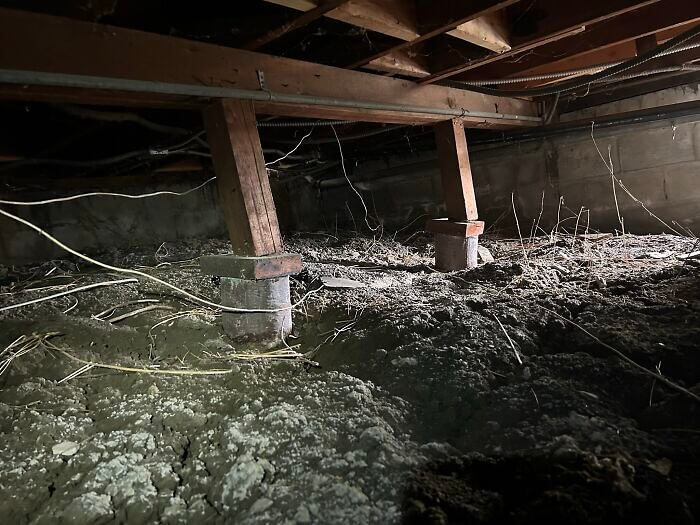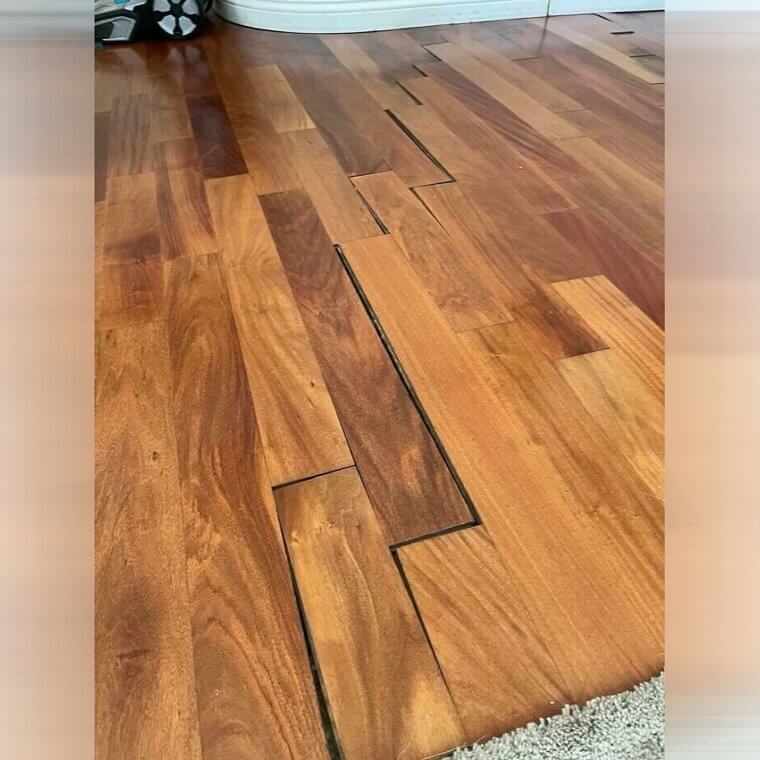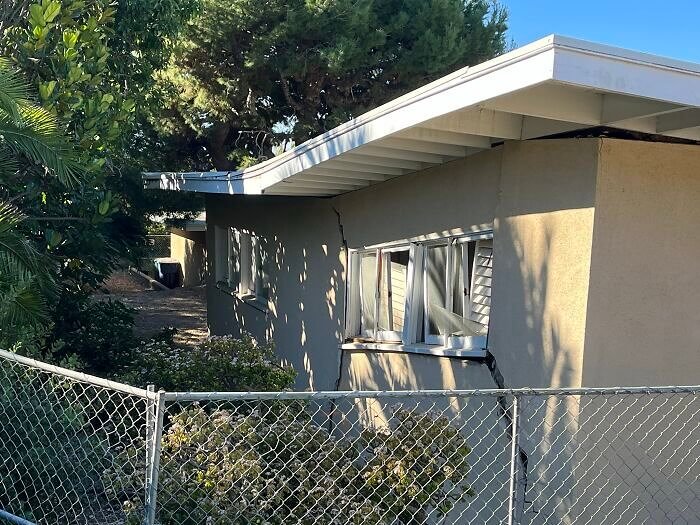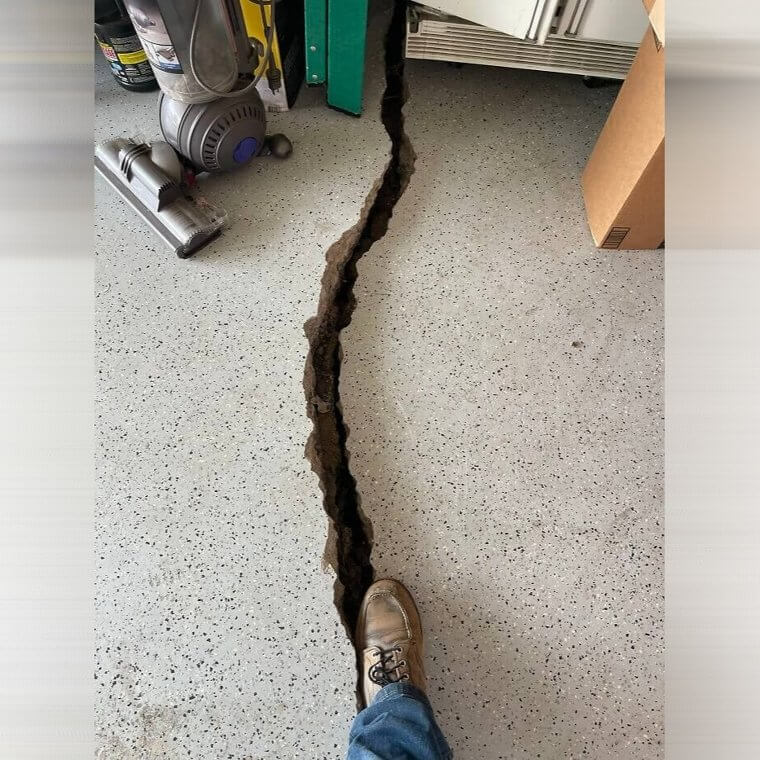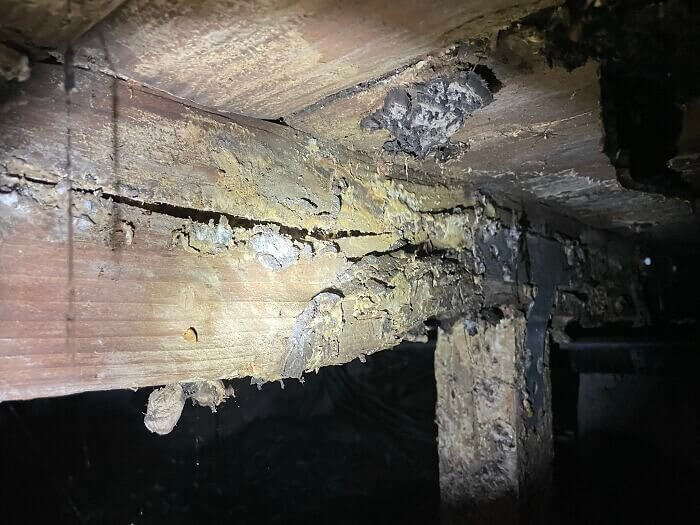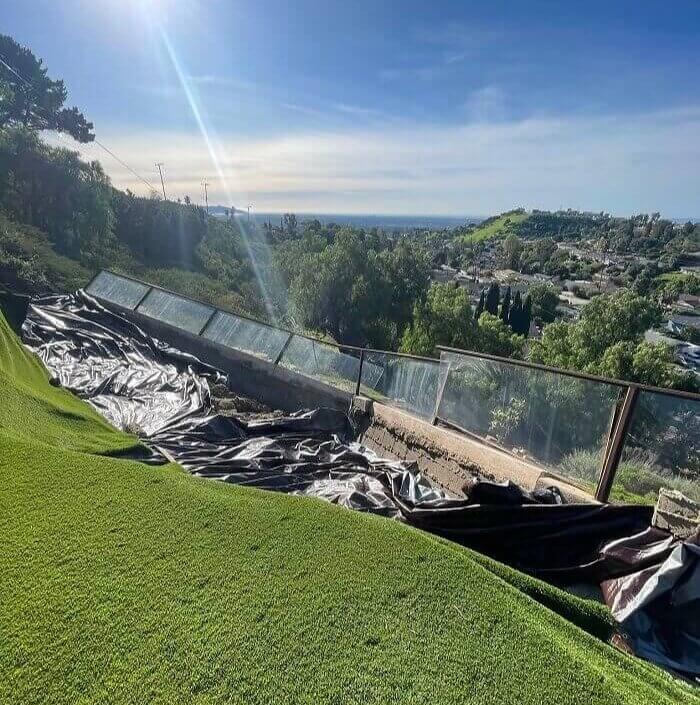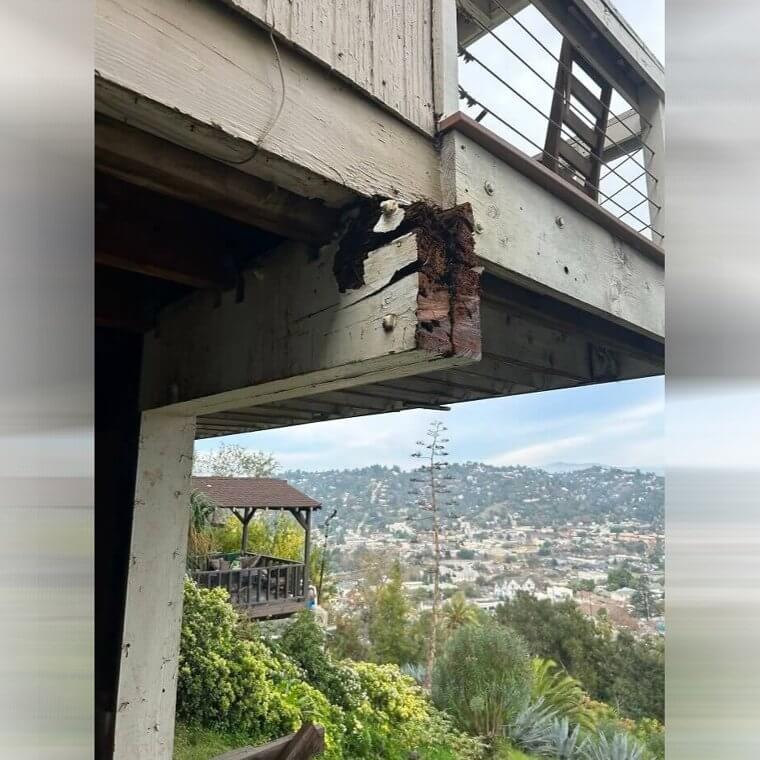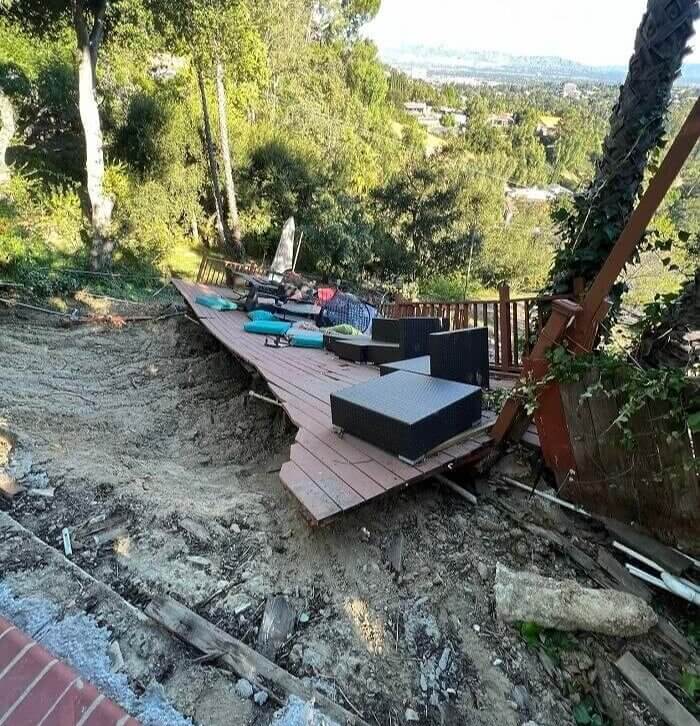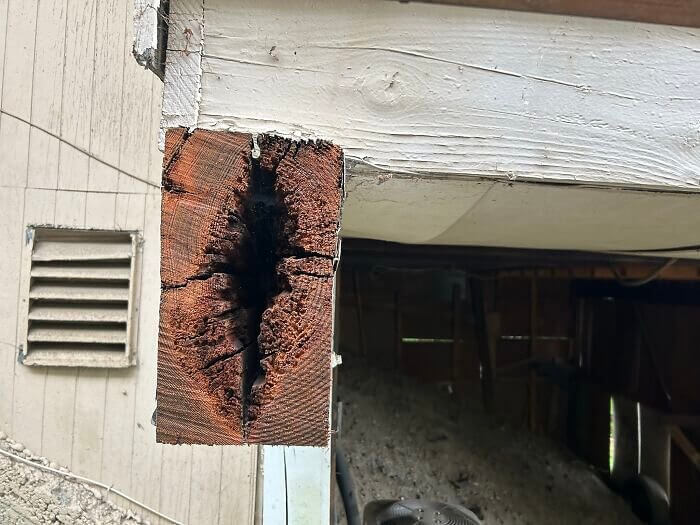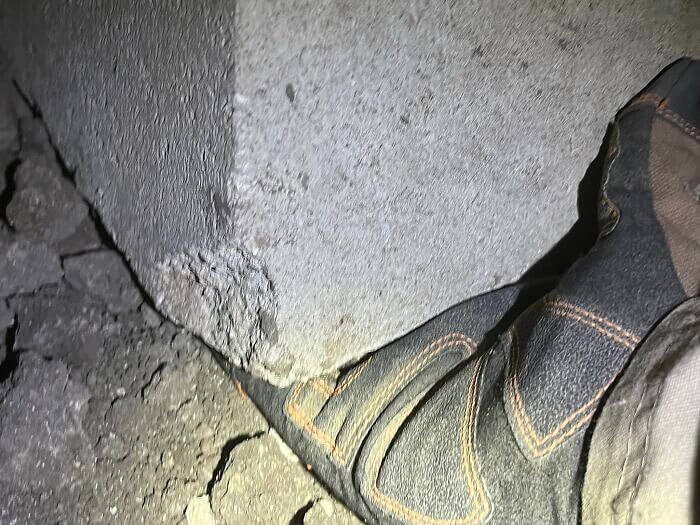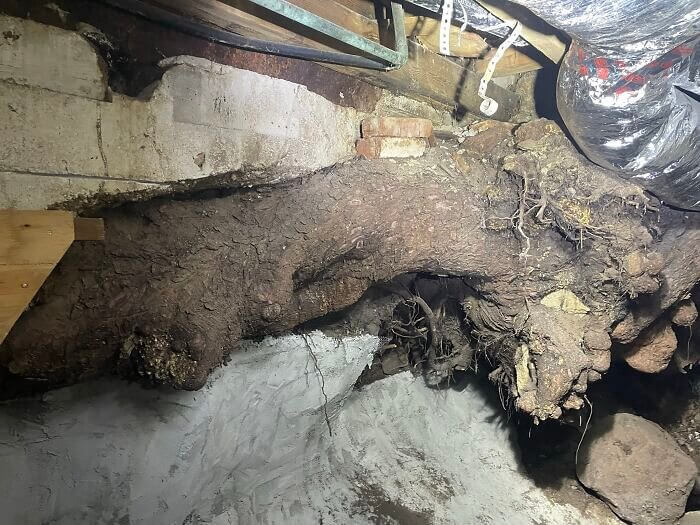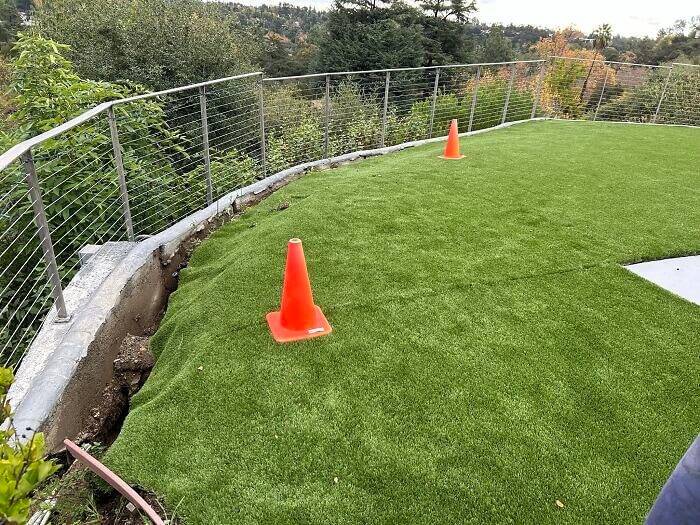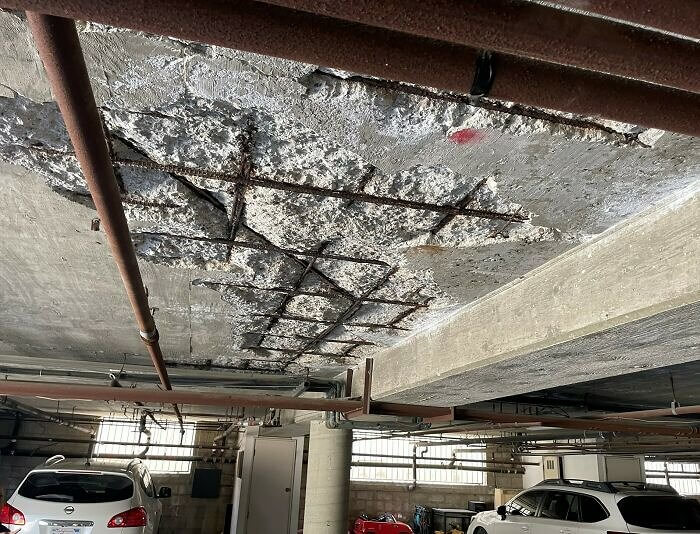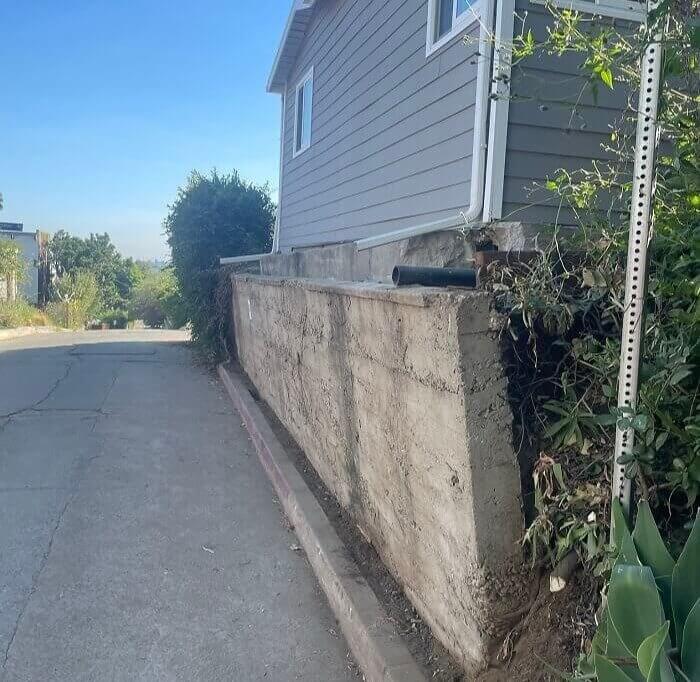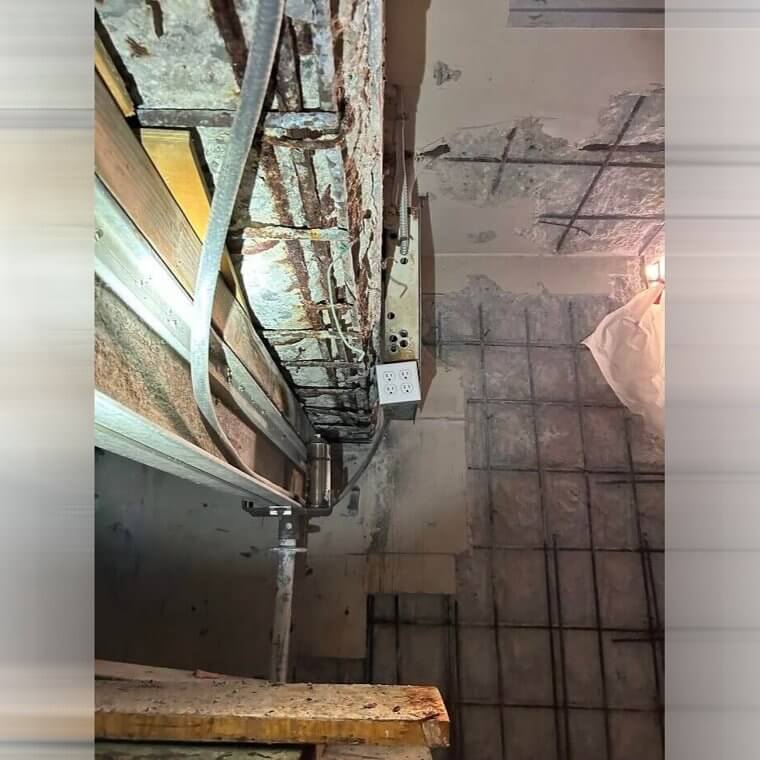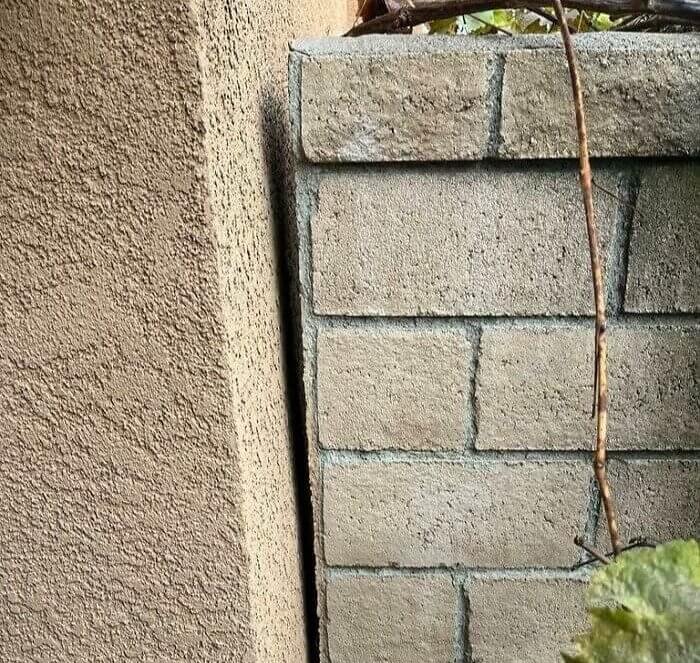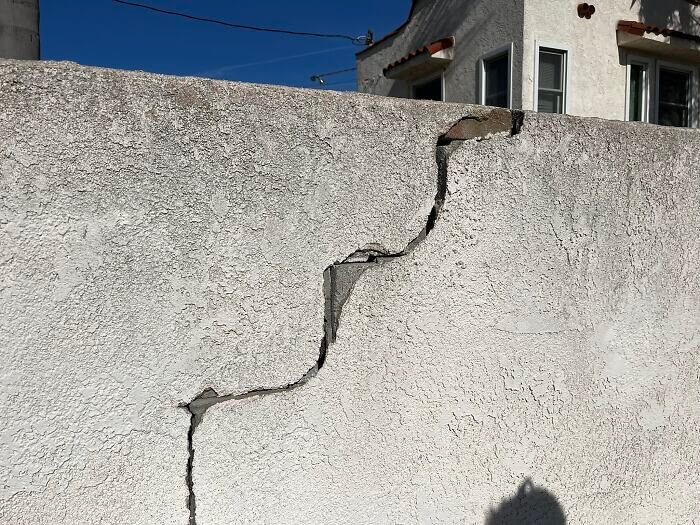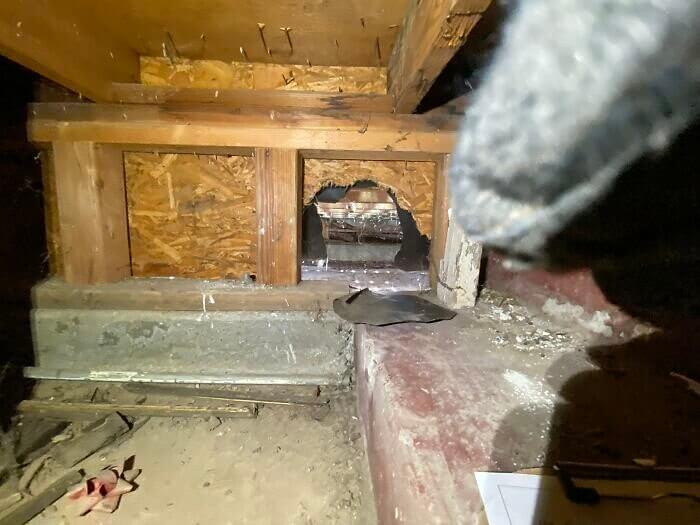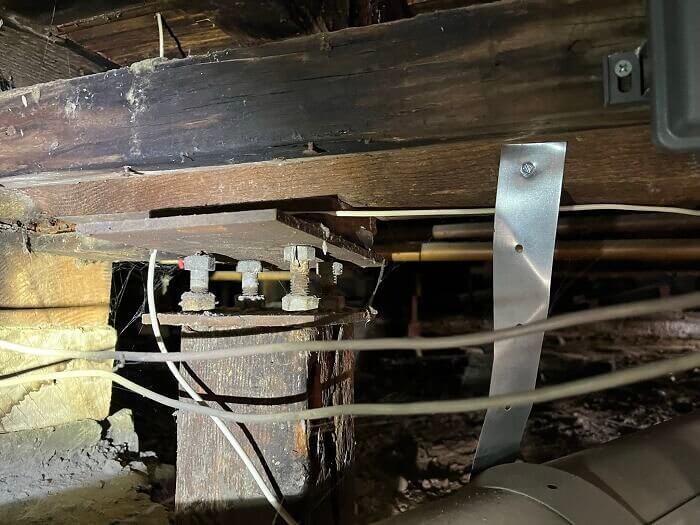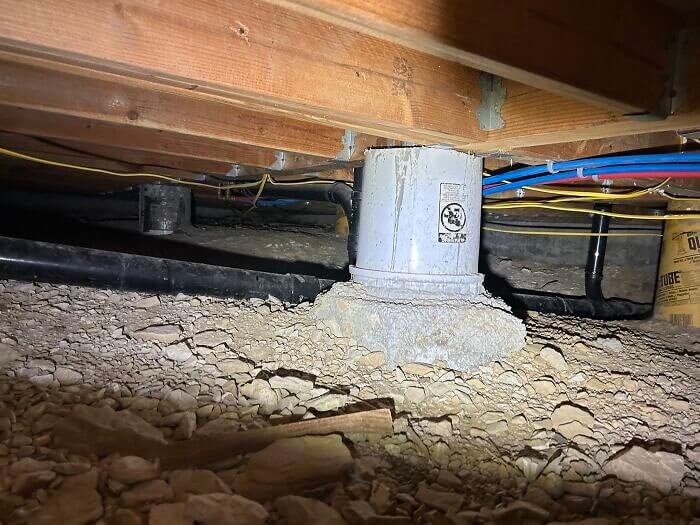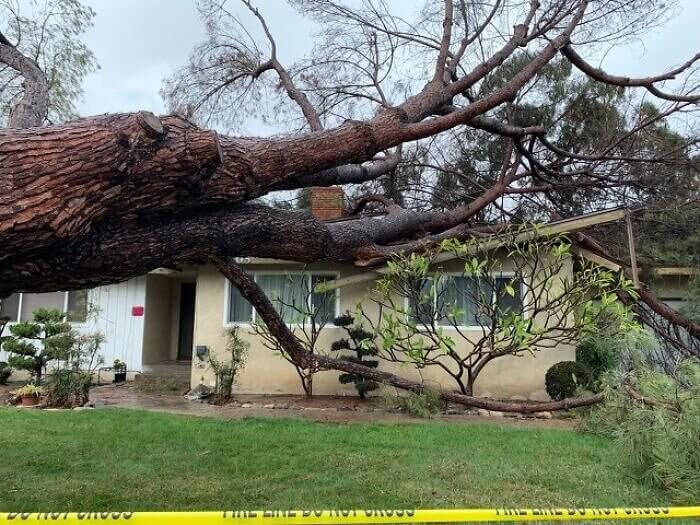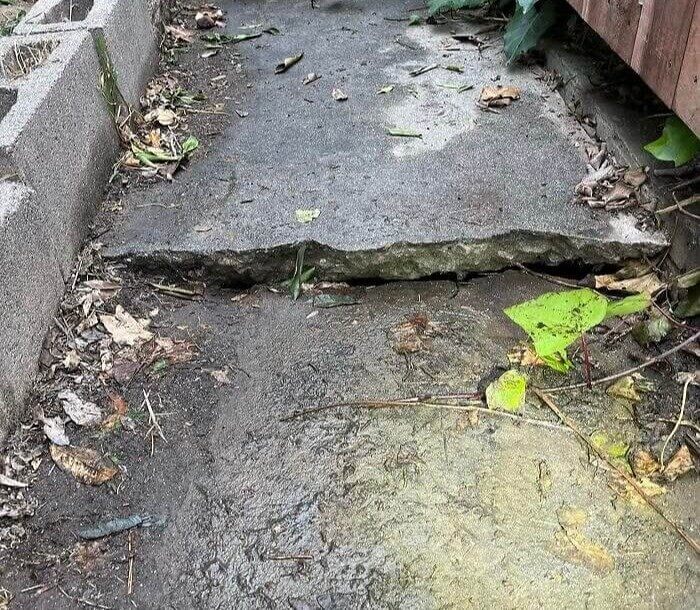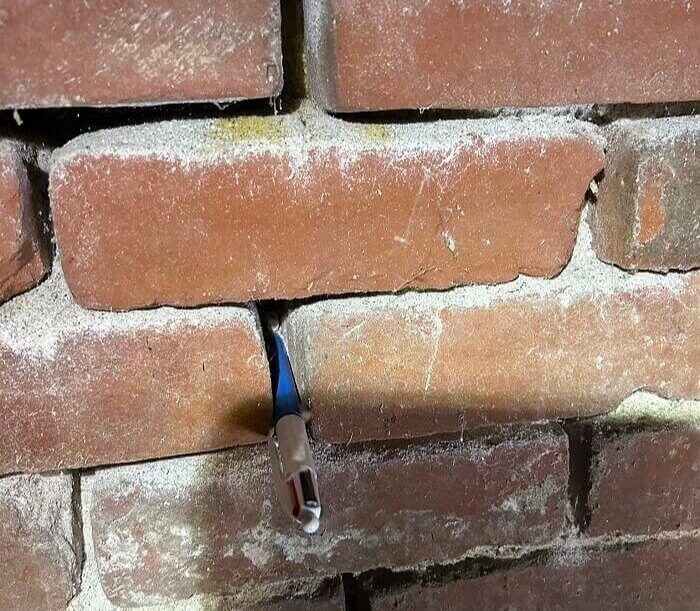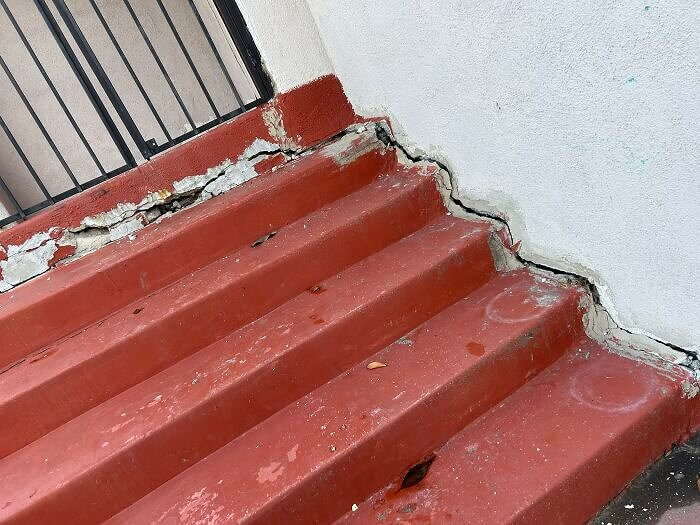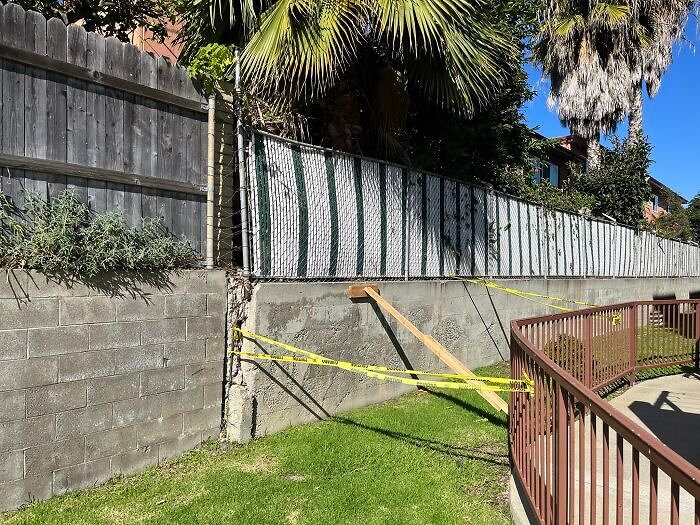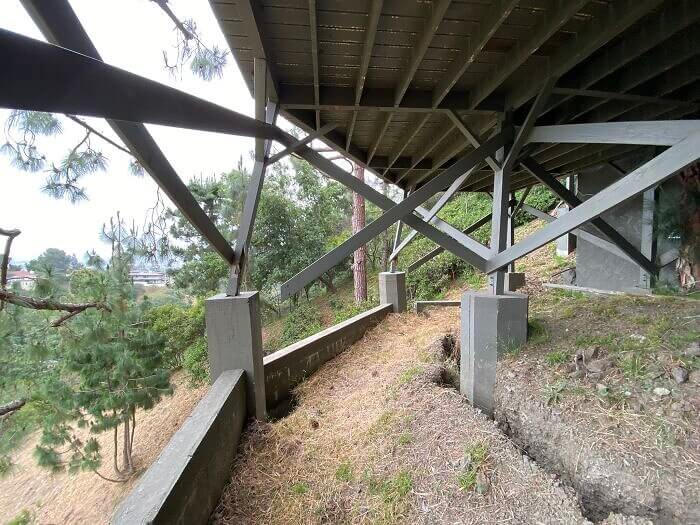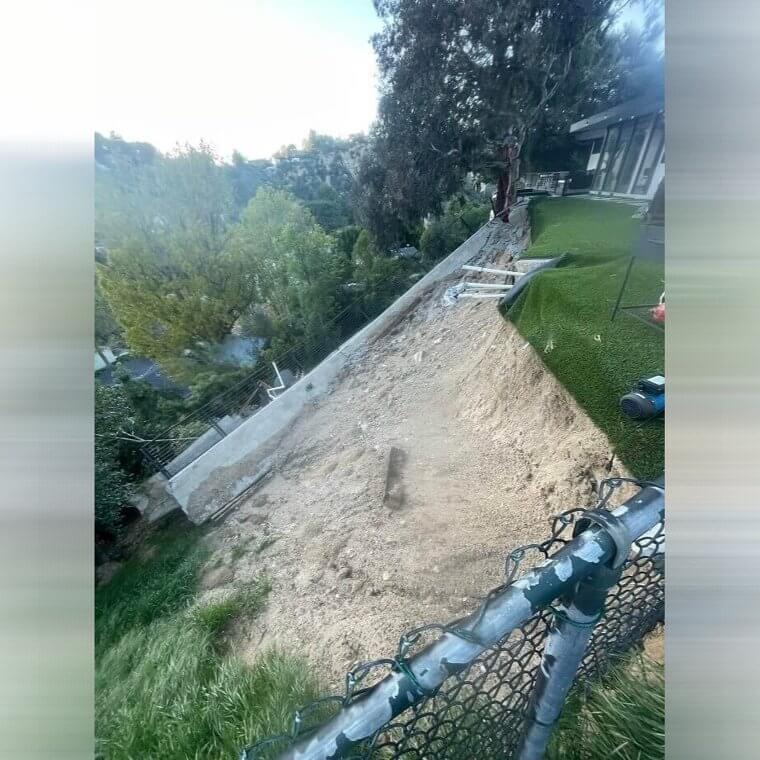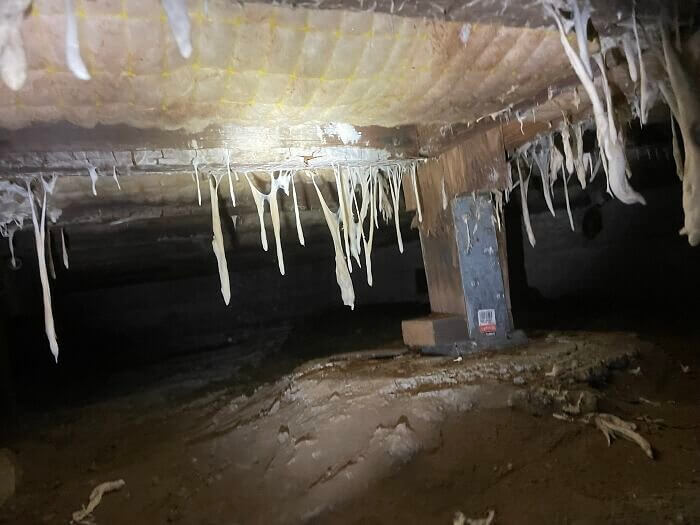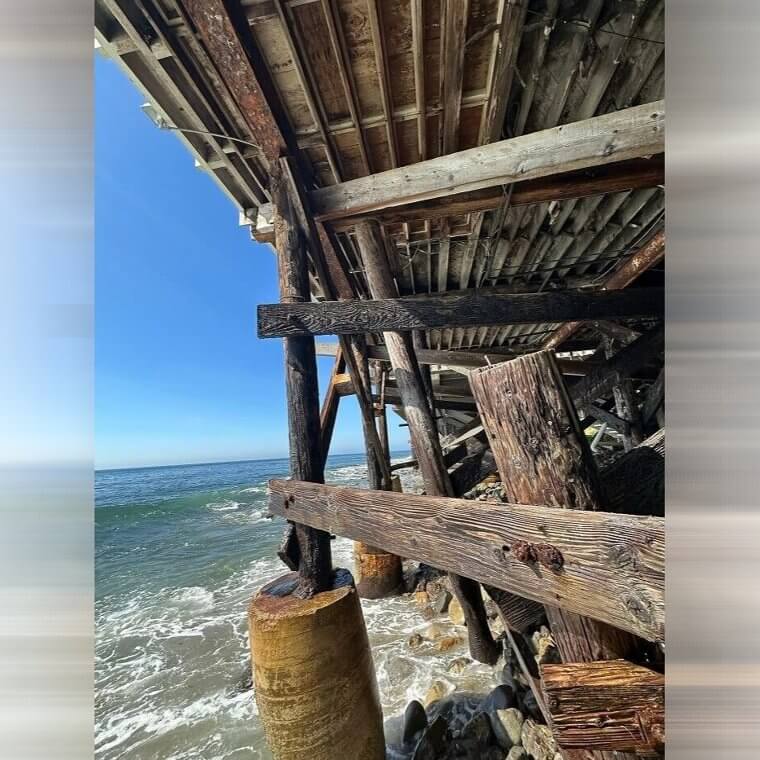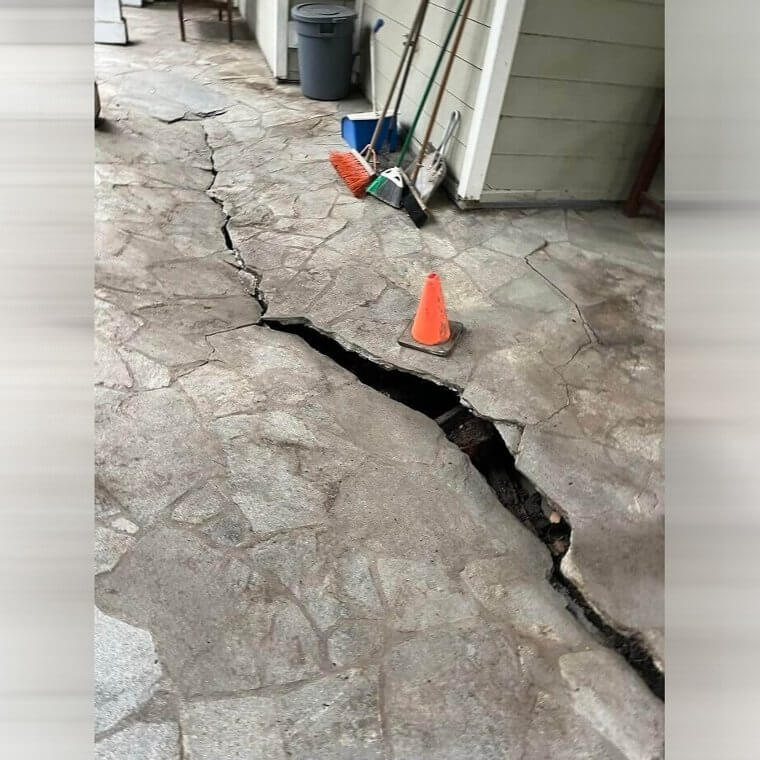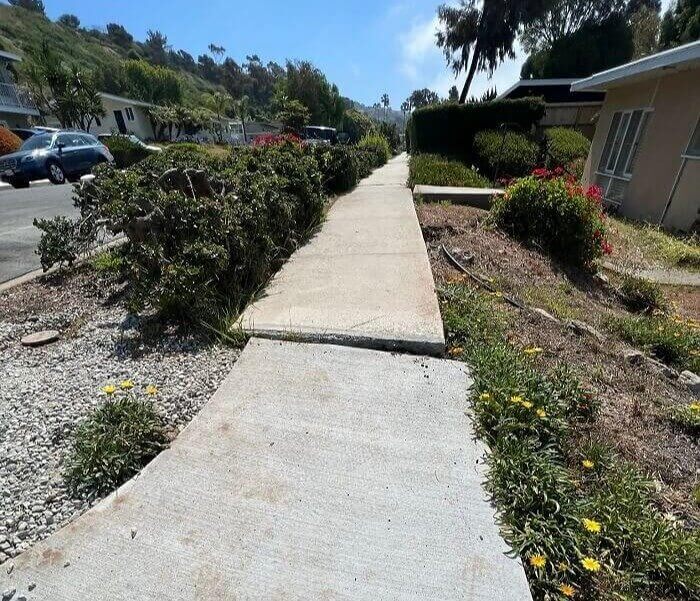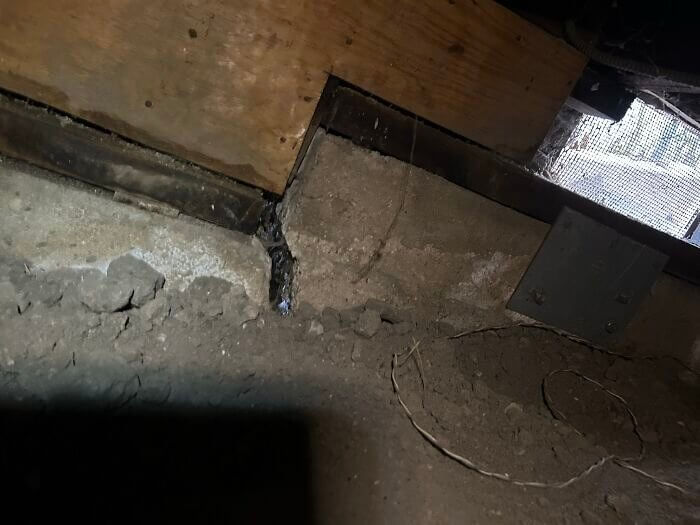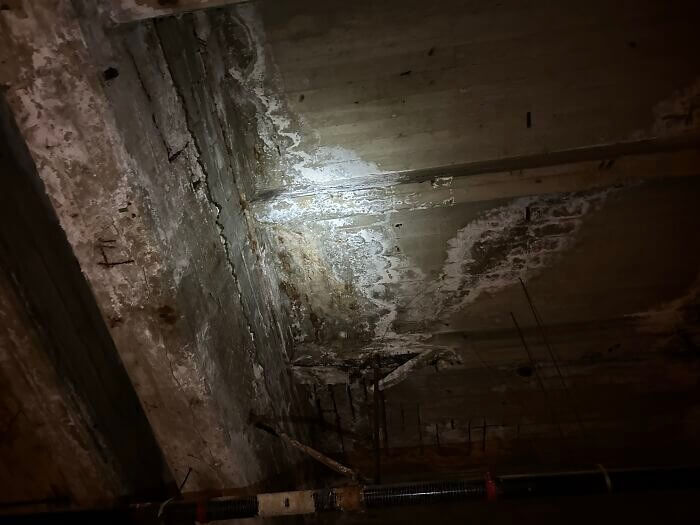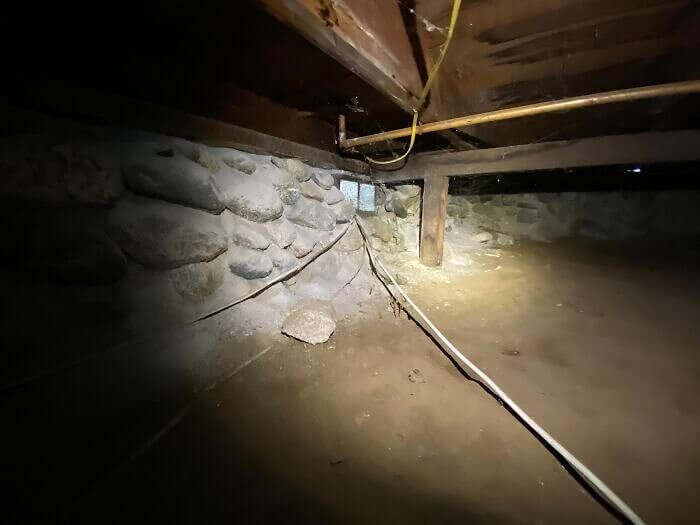Are the Posts Supposed to Bend Like That?
Home inspection services are often called-upon when a homeowner wants to complete a renovation. And this photo is proof that old houses should definitely be renovated at some point. After all, they don't last forever - especially when the house has been built on wooden posts! We bet the person who attended this structural inspection couldn't quite believe their eyes when they saw these posts quite literally bending under the weight of the house.
Let's hope this inspector didn't lean up against the house while he was giving the homeowners their quote. It looks like one push will send this house quite literally over the edge.
When the Foundations Split in Half
The foundation of any structure is super important. We've all played Jenga, after all. And if the bottom layers are broken or out of place, the whole thing comes tumbling down! This is the same thing with houses, which is why this home inspection service was so worried when they saw this house. At first glance, it looked like an issue with the homeowners' flooring. But it was something way more sinister.
This is actually the rest of the foundation of the home quite literally splitting in half, and the whole structure moving as a result. And we bet that wasn't a cheap or easy fix.
A Tetris-Inspired Pier and Beam Home
Anyone who knows anything about structural engineering and construction will know that pier and beam constructions aren't uncommon. In fact, they can be found across the globe. This form of construction allows for crawl space under the home, and this is where many home inspection services spend their time when they're undertaking structural inspections. And while pier and beams aren't always perfect, they very rarely remind them of a game of Tetris.
Not only have the beams been piled onto each other in a weird formation, but the concrete stumps also look as though they've just been shoved on top of each other. The whole thing is a disaster waiting to happen.
That Roof Is Supposed to Be Straight
Earthquakes are the bane of many people's lives, but there's no doubt about the fact that it keeps home inspection services running. And when the team arrived for this structural inspection, they could see just how much the recent earthquake had affected the house. The foundations had shifted, there were deep cracks running through the walls, and that's before we mention the roof that is supposed to be completely straight!
No, that bend in the roof was not an architectural choice. And while this house could have been repaired, it would have cost them a huge amount of money. So, we bet they just knocked the whole thing down instead!
Adult Foot Vs Differential Settlement
Differential settlement is something that is often picked up on structural inspections, but it's very rare to come across differential settlement that's so huge. As you can see from the foot for scale, the foundations are sinking at different rates underneath the house - and the whole thing is a complete mess. Just look at how deep those cracks go! That's definitely not something any homeowner ever wants to see.
Although we'd usually suggest shoving some duct tape on the crack and ignoring it, we have a feeling that duct tape wouldn't help in this situation. So, let's hope the structural engineer had a better solution.
This Fungus Isn't so Fun
When you think about it, the word 'fungus' is pretty misleading. There's absolutely nothing fun about fungus - especially when a whole load of it is found during a structural inspection. This picture was taken in the crawl space underneath a home, and it's clear to see that many of the beams, joists, and girders have become overrun with fungus. As you can imagine, this isn't a good sign at all.
Not only is this harmful for the people living in the house, but it's also potentially very dangerous. The more this fungus grows, the less structurally sound their house will be.
Hillside Properties and Rainstorms Don't Mix
Let's be honest; shows like Selling Sunset and Buying Beverly Hills have us dreaming of houses in the Hollywood Hills. And while there's no doubt that these houses are aesthetically beautiful, home inspection services will tell you that these houses aren't as structurally sound as you'd think. After all, you should never underestimate the power of water - especially when you live in the hills that are prone to landslides.
On this occasion, the water pushed down on the retaining wall so much that it bent and broke! Luckily for these homeowners, it only affected their backyard rather than their house as a whole.
These Support Beams Aren't Very Supportive
A support beam does exactly what it says on the tin; it supports the house. Because of this, the support beam needs to be strong and stable - and it definitely shouldn't be rotting from the inside. But that's exactly what the home inspection service spotted when they went to inspect this stilt home. And judging from that view, the house is pretty high up a hill, which makes this even scarier.
With something like this, the house would need to be completely renovated, and the beams would need to be completely replaced. That's not cheap, and it's not a stress-free process, either.
When You Leave the Pool Water Running
There's nothing better than having a pool, right? But having a pool also means an extra set of responsibilities. You need to maintain the cleanliness of the water, you need to keep it safe for your family, and you need to make sure that it's turned off when it needs to be turned off. Unfortunately, the pool service technician failed to do that when his clients went on vacation - and this is what happened as a result.
Yes, the whole backyard was caught in a pool-related landslide, and the decking has been pushed and demolished along the way. Let's hope the pool company had insurance, as we think there's a big claim coming their way.
If the Trees Are Bending, the Hill Is Unstable
Structural inspections are essential when you're building on a hill. Doing so is incredibly risky, as you just never know if the hillside is stable enough to build on or not. But looking at the trees around the property is a good indicator - and when the home inspection service went to check out a new construction on this property, they realized it was in grave danger. Just look at those trees!
If the trees are showing signs of bending, this is a clear sign that the hill is unstable and has been moving over the years. And if the trees are moving, what's stopping the foundations from moving?
Stilt Houses and Salt Water Aren't Friends
Hands up if you'd love to live in a beach house? We don't blame you. With endless views of the ocean, these beach houses offer your own personal slice of paradise - until you look down at the foundations and the stilts, anyway. That's because stilt houses and salt water aren't friends, and this home inspection service discovered that the footings of the house had almost completely been eroded by the salt water.
Without these footings, there's absolutely no support for the home! And that's before they saw the bizarre collection of beams strewn about the place. They weren't sure what was happening there.
No, Rotten Wood Beams Aren't Good
Although wooden beams are incredibly common, most new renovation projects also use steel beams to combat the many issues that come with using wood in construction. While some wooden structures and supports have no problems, some structural inspections uncover wood-rotted beams that compromise the integrity of the whole house. After all, the more rotten the beams become, the less support they offer the entire structure of the building and it becomes less stable.
The fact that this wood is rotten from the middle of the beam is even more concerning. Let's hope that this structural inspection was finished with a quote to remove and replace this rotten beam.
You Shouldn't Be Able to Slide a Hand Under a Pier
In pier and beam houses, the piers should be perfectly flush to the floor and perfectly in place. If they're not, the whole integrity of the house is compromised, and you run the risk of having a dangerous, unstable home. However, during this structural inspection, the home inspection service was able to slide their entire hand underneath the pier and lift it up. And you probably don't need us to tell you that that's not supposed to happen.
If the piers and posts were properly installed, there's no way that this would happen. So, we bet this was a pretty expensive fix on the homeowner's end. After all, they can't ignore it.
Nature Will Find a Way to Infiltrate a Crawl Space
Although having crawl space underneath your house is a great way to keep an eye on the foundations and complete any structural work without having to rip up the floor, these crawl spaces can also prove to be difficult - especially when nature always wants to infiltrate these areas. On this occasion, giant tree roots have taken solace in the dark and damp crawl space of this house, and crushed the foundations in the process.
While we're sure the owners of this house love a treehouse as much as the next guy, we bet they didn't expect their house to turn into a treehouse without their knowledge.
The Grass and the Wall Were Once Flush
In today's day and age, and much to many structural engineers' dismay, so many houses are built on hills and slopes. And while this isn't always an issue, sometimes it becomes a major issue when the hill starts to erode and slide away from the structure. And when this structural inspection took place, engineers saw this phenomenon for themselves. in fact, this grass and that wall were once installed to be flush with each other.
When the hillside began to erode, the wall began to fall with it, leaving a giant gap and height difference between them both. Now, it definitely doesn't look as good.
When Spall Damage Takes Hold
High-rise buildings are often built as concrete structures. And while this ensures that they're strong and stable, there's no denying the fact that concrete isn't bulletproof. Concrete can often fall victim to spall damage, and this can ultimately lead buildings to collapse. That's why it was such a worry when this home inspection service spotted this spall damage on the ceiling in the basement garage of this high-rise building block.
Left untreated, this whole ceiling could fall down, crushing the cars beneath and affecting the integrity of the building at the same time. So, let's hope that this was reported and rectified.
The Leaning Wall of the Parking Garage
At first glance, this may look like the side of any parking garage. But to those familiar with structural engineering and structural inspections, you'll know that this is so much more dangerous than that. If you look towards the top of this garage, you'll be able to see that the vehicle barrier wall is leaning to one side. And while this alarming on its own, what's even more alarming is the fact that it's not on the ground floor.
If that wall collapsed and fell to the ground, there's no telling the damage that it could do. Because of this, we really hope that this parking lot was renovated and repaired.
A Retaining Wall on Its Last Legs
A retaining wall is a super important piece of construction, especially when it's standing right next to a house. It keeps everything in place and provides vital support to the main structure. But as you can see from this picture, this retaining wall is on its last legs. The whole thing has been impacted by poor drainage and is being pushed over by the increased weight of the waterlogged soil behind it.
According to structural inspections, it's only a matter of time before this whole wall needs to be replaced. And we bet that isn't a cheap fix you can do yourself.
A Leaking Bathtub Gone Wrong
If you're not sure what you're looking at, this is the underside of a bathtub. And with that information in tow, it's time to put on your structural engineer hat and take a proper look at this picture. What can you see? Well, one major complaint we have with this picture is the fact that there's an electrical outlet underneath the bathtub itself. But another complaint we have is the spalling and exposed rebar on show.
You shouldn't be able to see either of these things, but a leak from the bathtub made these issues visible to the eye. And after the structural inspection, the homeowners were instructed to demolish and renovate the whole area.
What's That Gap for?
No homeowner wants to learn that they have issues with their home's foundations, but that's exactly why structural inspections can help you keep an eye on your structure. In an ideal world, you won't have any issues with your home. But in some cases - like this one - your foundation issues will cause all kinds of problems like your whole house moving. Yes, this wall and the house were once touching.
Over time, the house and the wall have moved away from each other, resulting in a gap that definitely shouldn't be there. And that's why proper maintenance is so important!
Always Fill the Holes in Cinder Blocks
There are two kinds of walls out there: structural walls that can affect the integrity of the home, and cosmetic walls that are just there for decoration or separation. And while decorative walls don't need to be as structurally sound as structural walls, they still need to be safe - and it's clear to see that this wall isn't safe. Just look at those huge cracks! They definitely shouldn't be there.
When the home inspection service was called out to this home, they soon realized that the builder had cut corners when building this wall. They hadn't filled the holes in the cinder blocks, resulting in a very weak structure.
That Hole Definitely Shouldn't Be There
When was the last time you went underneath your property and had a look around? We're going to assume that you don't do this very often, but this is what structural inspections are all about. During these inspections, they get into every nook and cranny to find any problems, and this engineer spotted just that when they saw this giant hole underneath someone's deck. And it definitely shouldn't have been there.
What's even more outrageous about this whole thing is that the homeowners had been complaining about the rodent issue they were dealing with. Well, we think they found their entry point!
A DIY Bodge Job Gone Wrong
There's nothing more annoying than spotting something wrong with your home. Sure, small renovations are ok, but big jobs are never fun - and they're never cheap. And this person obviously wanted to bypass the big check that came with fixing their pier and beam house, which is why they opted to level it out by themselves. To do this, they did a bodge job that included nuts and bolts being used as makeshift jacks.
As you can imagine, the home inspection service that saw this later on was outraged to see such a job. Not only is it dangerous, but they didn't even do a very good job!
A Bucket as a Pier? Just No
We've already seen so many pier and beam disasters, which just goes to show that people don't understand how integral these foundations are to a home. If you don't have the right support, your home could crumble in an instant! And that's why the person who went to this structural inspection was so shocked to see that someone had used a bucket to prop up the beams of their home.
Even if this bucket was full of concrete, it's still no replacement for a proper pier, and we dread to think how much this house has suffered as a result of this DIY disaster.
Oops, the Tree Hit the Roof
Roofs can handle most of the things that come their way. They can deal with strong winds, they can deal with wet conditions, and they can even deal with dry and arid temperatures. But when it comes to the battle between a roof and a giant tree, the tree is always going to win. And while most structural inspections would warn homeowners about the potentially dangerous trees near their property, some people just don't listen.
What makes this situation even worse is the fact that you can see this tree has been chopped and tidied up over the years. So, why didn't they cut the tree down in size, too?
Daylight Should Not Be Visible in a Crawl Space
If you've ever ventured down into the crawl space of your own home, you'll know that this area is pitch black. The whole idea is that it's shut off from the world and kept safe and secure to maintain the structure of your house. But when the home inspection service went into the depths of this crawl space, they were pretty confused when they realized that they didn't need to use their flashlights.
Instead, there was already a hole in the wall! A compromised crawl space is never good, as this can cause serious issues with mould, pests, moisture, and potential structural problems.
That Crack Wasn't on the Plans
Home inspection services don't just focus on the interior of a house, as they also perform structural inspections on the outside of your home. They were called out to this home, which has a small sidewalk between it and the house next door. But when this sidewalk was undermined by water, a crack was formed in the foundations, resulting in the water flowing down the hill and eroding the neighbors' backyard.
As you can imagine, that crack isn't supposed to be there. And as this sidewalk belonged to the homeowner, we have a feeling that they probably had to foot the bill for their neighbors' yard.
How Many Pens Can You Fit in the Bricks?
Although modern renovations use new and innovative building materials, bricks and mortar are still extremely popular. When built correctly, brick walls can be incredibly strong - but to be built correctly, the gaps in between the bricks need to be filled with the mortar. Otherwise, you could just push the whole thing down! And while any seasoned builder will know that, this structural inspection came to the conclusion that a cowboy builder had built this wall.
In an ideal world, you shouldn't be able to fit a single pen inside of the gaps in the wall. But in this case, it looks as though you could fit a whole store's worth of pens inside the gaps.
When the Stairs Come Away From the House
Home inspection services are used to seeing settlement in homes. Minor settlement is normal in new constructions as they 'settle' on their new foundations, but settlement in older properties is a major cause for concern. If the foundations aren't strong enough or compromised in any way, parts of the house can crumble under the weight. And in this case, the staircase was suffering as a result of this underground movement.
As you can see, the front portion of the home and the stairs are shifting away from each other, separating the stairs from the house completely. A few more years and they'll have crumbled.
The Retaining Wall Is Being Iced Out
Ever felt like you're being pushed out of a group of friends? Well, that's essentially what's happening here. Although this wall was once a huge part of this backyard, the tree behind it obviously thought that it was a bigger deal. The bigger its roots have grown, the more they have started to push the wall out of position. And as you can see, the wall looks completely warped and out of place.
The home inspection service was called to check this out, and we doubt they were very impressed with this homeowner's lackluster attempt to prop the wall up with some two-by-fours.
Those Support Beams Should Be Connected
As we've already seen so far, hillside properties are prone to movement and erosion. Because of this, they need to be built on strong and stable supports that should keep them above ground at all times. And at first glance, it looks as though this house could be very well supported. After all, there's a huge maze of support beams under the house, and they're all crossing over each other for extra support.
But when you take a closer look, you can see that some of the beams are completely disconnected from anything. With this in mind, they'll offer absolutely no structural support.
No Parking, Please
Structural inspections uncover all kinds of problems when they make their way under the crawl space of a house. They're used to seeing unsuitable piers and beams, they're used to seeing mould and fungus, and they're even used to seeing worrying electrics and piping. And while the rust on the steel beam underneath this house was certainly worrying, there's no doubt that this sign made them chuckle a little bit.
Of course, there's absolutely no need for a 'No Parking' sign underneath this home, but the fact that it's there is pretty funny. Perhaps it's a parking space for ants?
Thank Goodness the Trees Caught This Wall
Retaining walls are even more important when they're built on the grounds of hillside properties. But home inspection services are regularly making their way out to homes just like this one, which have suffered erosion, and the walls have completely given way. This normally happens when the retaining wall has not been built to code and has not been built to withstand the changing environments of the hillside. That's exactly what happened here.
On this occasion, the homeowners were lucky. If the retaining wall hadn't been caught by the trees below, it would have slid right down into their neighbors' roof - and that would have been expensive.
That Much Fungus Is Not a Good Sign
When you think of fungus, you might think of disgusting mold or mushroom-like additions that hang off a structure. But have you ever seen fungus quite like this before? The home inspection service audibly gasped when they made their way under the house and saw this with their very eyes. And we don't blame them. It's not every day you see fungus quite literally dripping down from the floor above it.
You can also see that the wood looks wet and rotten, and the material the floor is made from is bowed and misshapen. Let's hope this whole thing was completely replaced.
It's Time to Say Goodbye to This House
Beachfront houses often sell for millions of dollars, as everyone wants to live on stilts above the beach and above the water. But it's important to know what you're getting yourself into if you buy one of these houses, and it's important to check the building quality before signing on the dotted line. After all, everyone knows that wood and saltwater don't mix, so why would you buy an old oceanfront property made from wood?
When the home inspection service looked underneath this house, they saw that all of the beams were bowed, some of them had completely eroded, and the whole thing looked like it was on its last legs.
When a Bad Leak Goes Awry
Leaks are fairly common in houses across the globe. You might leave the faucet on when running a bath, you might have faulty piping, or you might suffer extreme weather. But one thing you need to know is that a huge amount of water can have a big impact on the structural integrity of your home. This family didn't need a structural inspection to know that the leak deterred the supporting structure underneath their deck.
They could immediately tell something wasn't right when the deck collapsed and left a giant crack in the middle of it. But a least they put a cone out to warn people, right?
If a House Moves, so Does the Sidewalk
By now, you should know that settlement issues are more common than you'd think, with home inspection services finding settlement issues on a regular basis. But it's not very often they come across a house that has moved so much that it's actually shifted the public sidewalk in front of it. That's what happened here, and you can see just how much this sidewalk has moved and how dangerous it is now.
It was easy to diagnose the problem during this structural inspection, but the engineers weren't just worried about this house. This whole situation made them question the integrity of the whole street.
Seeing Settlement From Down Below
Most people don't like crawling underneath their home, as it's dark, dusty, and pretty creepy. But sometimes, looking at your home from down below is the best way to see what's really happening - especially if you're experiencing issues with your flooring or cracks in your walls. When the home inspection service was called to this property, they immediately headed underground and saw immediately what the problem was. That's what settlement looks like from below.
You can see a huge gap and a crack between the wood and the concrete, and that gap is definitely not supposed to be there. Instead, it's all supposed to be flush.
Your Home's Worst Enemy: Efflorescence
When someone describes you as effervescent, you should definitely take it as a compliment. But when a home inspection service tells you that you have efflorescence, you should immediately check your bank account because you're going to need a lot of money to solve that problem. Efflorescence is the result of dissolved minerals migrating through a solid and staining it in the process, and this normally means that there's a huge (and constant) water leak.
The fact that the structural inspector spotted this wasn't good for the homeowners, but it was good for the home. This way, they could focus on solving the issue and fixing the problem.
This River Rock Won't End Well
There are so many building materials out there, and builders often use different types of materials to build foundations. But any good builder will avoid using river rock for this process, as it's extremely unstable and requires various other reinforcement and engineering to be safe and secure for a home. That didn't stop the builder behind this house from using it, though - and in a seismic-prone area, no less.
When the home inspection service saw the underneath of this house, they weren't impressed. Not only was it made with river rock, but there's very little else supporting this structure.

